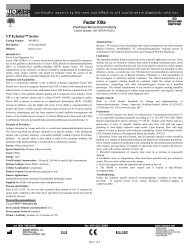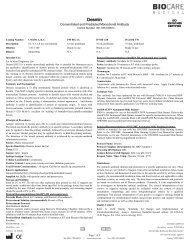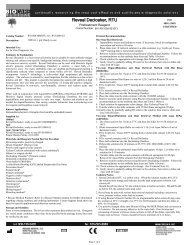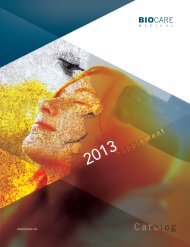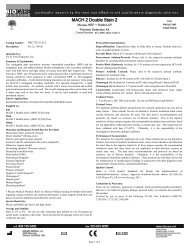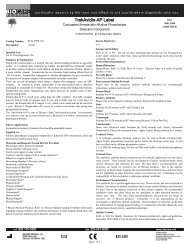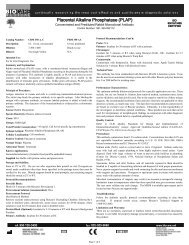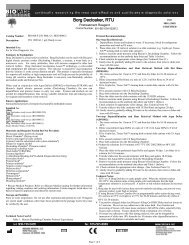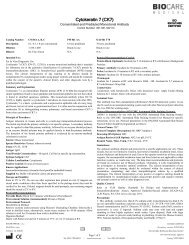RISH⢠AP Detection Kit - Biocare Medical
RISH⢠AP Detection Kit - Biocare Medical
RISH⢠AP Detection Kit - Biocare Medical
You also want an ePaper? Increase the reach of your titles
YUMPU automatically turns print PDFs into web optimized ePapers that Google loves.
RISH <strong>AP</strong> <strong>Detection</strong> <strong>Kit</strong><br />
(Chromogenic <strong>Detection</strong> of Digoxigenin Labeled Probes)<br />
ISO<br />
9001&13485<br />
CERTIFIED<br />
Control Number: 901-RI0213-010814<br />
Catalog Number:<br />
Description:<br />
Intended Use:<br />
For In Vitro Diagnostic Use<br />
Summary & Explanation:<br />
RI0213 KG<br />
6ml (Approximately 40 tests)<br />
The <strong>Biocare</strong> RISH <strong>AP</strong> <strong>Detection</strong> <strong>Kit</strong> is to be used for the revealing of RISH probes<br />
with the red end-point. Under optimal conditions, RISH probes specifically hybridize<br />
to cognate mRNAs or DNA in formalin-fixed paraffin-embedded (FFPE) tissues. The<br />
<strong>Biocare</strong> RISH <strong>AP</strong> <strong>Detection</strong> <strong>Kit</strong> provides reagents and materials for the preparation,<br />
pretreatment, hybridization and detection of digoxigenin labeled probes.<br />
Species Reactivity: Digoxigenin labeled probes on human tissues<br />
Cellular Localization: Cytoplasmic or nuclear dependant upon probe<br />
Known Applications:<br />
in situ hybridization on formalin-fixed paraffin-embedded (FFPE) tissues<br />
Supplied As:<br />
1. RISHzyme (RI0200G) 6ml<br />
2. RISHzyme Buffer (RI0201G) 6ml<br />
3. RISH Secondary Reagent (RI0203G) 6ml<br />
4. RISH <strong>AP</strong> Tertiary Reagent (RI0212G) 6 ml<br />
5. Warp Red Chromogen (WR806CHE) 0.7ml<br />
6. Warp Red Substrate Buffer (WR806BFH) 25ml<br />
7. Mixing Vial (RMVL103)<br />
Materials and Reagents Needed But Not Provided:<br />
Decloaking Chamber (pressure cooker)*<br />
RISH Retrieval Solution<br />
RISH Probe<br />
IQ Kinetic Slide Stainer* or other hybridization oven<br />
IQ Aqua Sponge*<br />
Microscope slides, positively charged<br />
Desert Chamber* (Drying oven)<br />
Positive and negative tissue controls<br />
Xylene (Could be substituted with xylene substitute*)<br />
Ethanol or reagent alcohol<br />
Deionized or distilled water<br />
TBS wash buffer (TWB945)*<br />
Hematoxylin*<br />
Bluing reagent*<br />
Mounting medium*<br />
Peroxidase*<br />
HybriSlip (or equivalent)*<br />
Thermal Test Strips*<br />
* <strong>Biocare</strong> <strong>Medical</strong> Products: Refer to a <strong>Biocare</strong> <strong>Medical</strong> catalog for further information<br />
regarding catalog numbers and ordering information. Certain reagents listed above are<br />
based on specific application and detection system used.<br />
Storage and Stability:<br />
Store kit at 2ºC to 8ºC. Do not use after expiration date printed on vials. If reagents are<br />
stored under conditions other than those specified in the package insert, they must be<br />
verified by the user. Diluted reagents should be used promptly; any remaining reagent<br />
Protocol Recommendations:<br />
1. Deparaffinization<br />
a. Deparaffinize slides as per standard procedures.<br />
b. Perform 5 minute hydrogen peroxide block.<br />
c. Wash with distilled water, and place onto IQ Stainer at room temperature (RT).<br />
2. Protein Digestion/ Retrieval<br />
The following recommendations should be used as a starting point for tissues fixed<br />
24 hours or longer. Tissues fixed less than 24 hours may require a further dilution<br />
of RISHzyme to buffer and/ or a heat pretreatment at lower temperature.<br />
a. Prepare digestion reagent (1:2) by combining 1 part enzyme to 1 part buffer. If<br />
tissues appear over-digested, consider: 1:3, 1:4 or 1:5 digestion reagent to buffer.<br />
(Working solution is stable for 7 days at 4ºC).<br />
b. Place 200 µl onto tissue sample for 1 minute at RT.<br />
c. Wash twice with distilled water, 2 minutes each wash.<br />
d. Retrieve section with RISH Retrieval using <strong>Biocare</strong>’s Decloaking Chamber*,<br />
followed by a wash in distilled water.<br />
i. Suggested parameters: 90°C for 15 minutes, followed by 10 minute cool down in<br />
RISH Retrieval. If tissues appear over-digested, retrieve sections at 80°C or lower<br />
for 15 minutes followed by 10 minute cool down in RISH Retrieval.<br />
ii. Wash in distilled water<br />
iii. See technical notes if using a water bath or hotplate<br />
3. Probe Hybridization<br />
a. Use Kimwipe to wipe off excess water around tissue section.<br />
b. Apply 20 µl of RISH probe onto tissue section and cover slip with 22×22mm cover<br />
slip.<br />
c. Place slides onto a preheated IQ Kinetic Slide Stainer** or humidity chamber at<br />
37°C (DNA targeting probes) for 60 minutes or 55°C (mRNA targeting probes) for<br />
30-60 minutes.<br />
Note: RISH DNA Targeting Probes (CMV, etc) require denaturation at 95°C for 5<br />
minutes prior to the 60 minute hybridization at 37°C.<br />
4. Post-Hybridization Washing<br />
a. Remove slides from incubation and put directly into TBS at RT. Briefly agitate<br />
until cover slip comes off.<br />
b. Wash 5 minutes in TBS wash buffer at 55°C. Then, place slides in TBS wash buffer<br />
at RT for 5 minutes. Slight agitation in buffers and stringency wash is recommended.<br />
5. <strong>Detection</strong> of Probe<br />
a. Remove slides from TBS and use a Kimwipe to wipe around the edges of tissue.<br />
Apply P<strong>AP</strong> Pen, if necessary.<br />
b. Place slides onto RT IQ Stainer or slide rack.<br />
c. Decant TBS, and put 4 drops of RISH Secondary Reagent (3) onto tissue sample,<br />
and incubate for 15 minutes.<br />
d. Wash with TBS twice, 2 minutes each.<br />
e. Decant TBS. Add 4 drops RISH <strong>AP</strong> Tertiary Reagent (4) onto tissue sample and<br />
incubate for 15 minutes.<br />
f. Wash with TBS twice, 2 minutes each.<br />
g. Decant TBS. Apply 4 drops of prepared Warp Red (5-6) to tissue samples and<br />
incubate for 5 to 10 minutes (mix 1 drop chromogen to 2.5 ml of buffer).<br />
h. Wash with distilled water and examine slides on microscope prior to<br />
counterstaining.<br />
6. Counterstaining<br />
a. Briefly soak slides in CAT Hematoxylin for 5-6 seconds. Immediately rinse with<br />
distilled water. Excessive counterstaining will obscure specific signal. Reduce time<br />
in hematoxylin if too dark.<br />
b. Soak slides in Tacha’s Bluing Solution for 5-6 seconds, and rinse with distilled<br />
water.<br />
7. Cover Slipping<br />
a. Dehydrate through graded alcohols and finish in xylene.<br />
b. Apply 1 drop of mounting media to an appropriate cover slip and mount.<br />
c. Allow to dry.<br />
Page 1 of 3
RISH <strong>AP</strong> <strong>Detection</strong> <strong>Kit</strong><br />
(Chromogenic <strong>Detection</strong> of Digoxigenin Labeled Probes)<br />
ISO<br />
9001&13485<br />
CERTIFIED<br />
Control Number: 901-RI0213-010814<br />
should be stored at 2ºC to 8ºC.<br />
Technical Notes:<br />
The <strong>Biocare</strong> RISH <strong>AP</strong> <strong>Detection</strong> <strong>Kit</strong> has been developed to detect digoxigenin labeled<br />
RISH probes by in situ hybridization. Routinely processed (FFPE) tissues in which the<br />
presence of cognate nucleic acid target is anticipated can be used.<br />
<strong>Biocare</strong>’s IQ Kinetic Slide Stainer was used for hybridization and post-hybridization<br />
detection steps of RISH probes. <strong>Detection</strong> steps can also be programmed on an<br />
automated staining system (see below).<br />
Commercially available hybridization chambers can be used, but measures should be<br />
taken to ensure that chamber is hermetically sealed during hybridization. Both<br />
incubator and humidity chamber must be at 55 ºC (mRNA targeting probes) or at 37°C<br />
(DNA targeting probes) when hybridizing probe.<br />
*If a Decloaking Chamber or pressure cooker is not available, consider using a water<br />
bath or hot plate for retrieval. Place RISH Retrieval (1X) in glass (Pyrex) container<br />
and heat solution until the appropriate temperature is achieved (90°C). Heat slides in<br />
this solution for 15 minutes. Remove slides after incubation, and immediately wash in<br />
distilled water. Proceed with probe hybridization.<br />
**The IQ Stainer can be used as an incubation and humidity chamber by using the IQ<br />
Aqua Sponge. Saturate IQ Aqua Sponge with distilled water, and place on hot bar set<br />
to 55°C (mRNA targeting probes) or 37°C (DNA targeting probes) for hybridization.<br />
Use the clear plastic hood to contain heat and moisture.<br />
If using the IQ1000 (single hot bar) place slides onto rack and denature on hot bar at<br />
95°C for 5 minutes. After denaturation, remove rack and place on bench. Turn off hot<br />
bar and unplug unit. Cool hot bar (3-5 minutes) with running tap water until bar<br />
approximates 35-40°C. Re-set hot bar to hybridization temperature (37°C). Place<br />
water-saturated IQ Aqua sponge and a thermometer onto hot bar before hybridization.<br />
Check the temperature on the hot bar. It should not be higher than 40°C. Place rack<br />
with slides onto sponge, cover unit and incubate for 1 hour.<br />
If probe appears cloudy, briefly vortex and heat to hybridization temperature (37°C or<br />
55°C) before application.<br />
The use of probe in amounts less than recommended may lead to inconsistent results.<br />
<strong>Detection</strong> of RISH probes may be performed on <strong>Biocare</strong>'s intelliPATH Automated<br />
Stainer with intelliPATH Warp Red Chromogen <strong>Kit</strong> (IPK5024). Contact <strong>Biocare</strong>'s<br />
Technical Support Staff for protocol recommendations.<br />
Bone Marrow Biopsies:<br />
For optimal results, bone marrow biopsies should be fixed for 24 hours in 10% neutral<br />
buffered formalin (NBF) or zinc formalin prior to decalcification. <strong>Biocare</strong><br />
recommends for preservation of RNA integrity that bone marrows are decalcified in a<br />
formic acid or 10% EDTA based solution 1, 2 . However, there are many methods of<br />
fixation and decalcification used in the clinical laboratory. The table below represents<br />
parameters and tissues that have tested positive for kappa / lambda mRNA RISH<br />
probes in our laboratory. All decalcification methods, including those mentioned,<br />
should be empirically determined for optimal pretreatment parameters. <strong>Biocare</strong>’s<br />
protocol recommendations for the ratio of enzyme to buffer (1:2) should be used as a<br />
starting point for tissues fixed 24 hours or longer. Tissues fixed less than 24 hours may<br />
require a dilution of RISHzyme to buffer of 1:4 and a heat pretreatment of 80°C for 15<br />
minutes to prevent digestion artifacts.<br />
Check for completion of decalcification by in-house methods and process tissues into<br />
paraffin according to standard procedures.<br />
Fixation Decalcification Digestion of Bone marrow positive<br />
RISHzyme: by RISH<br />
buffer<br />
NBF 10% HNO 3 1:2-1:4 Plasma cell myeloma,<br />
Thoracic myeloma<br />
NBF+zinc *FA / Form 1:2-1:4 Bone marrow clinically undefined<br />
NBF RDO 1:2-1:4 Bone marrow clinically undefined<br />
NBF+zinc RDO 1:2-1:4 Bone tumor plasma cell myeloma<br />
*FA / Form = formic acid / formaldehyde (Formical-4)<br />
Precautions<br />
1. Some components in this kit are classified as hazardous. Consult the MSDS for each<br />
component in order to determine appropriate handling procedures. Visit the <strong>Biocare</strong><br />
<strong>Medical</strong> website at http://biocare.net/support/msds/ for the current MSDS.<br />
2. Specimens, before and after fixation, and all materials exposed to them should be<br />
handled as if capable of transmitting infection and disposed of with proper precautions.<br />
Never pipette reagents by mouth and avoid contacting the skin and mucous membranes<br />
with reagents and specimens. If reagents or specimens come in contact with sensitive<br />
areas, wash with copious amounts of water.<br />
3. Microbial contamination of reagents may result in an increase in nonspecific<br />
staining.<br />
4. Incubation times or temperatures other than those specified may give erroneous<br />
results. The user must validate any such change.<br />
5. Do not use reagent after the expiration date printed on the vial.<br />
Follow the DNA probe specific protocol recommendations according to the RISH <strong>AP</strong><br />
<strong>Detection</strong> <strong>Kit</strong> data sheet. If atypical results occur, contact <strong>Biocare</strong>’s Technical Support<br />
at 1-800-542-2002.<br />
Troubleshooting guide:<br />
No Staining<br />
1. Critical reagent (such as probe) omitted<br />
2. Incorrect hybridization temperature (check temperature)<br />
3. Staining steps performed incorrectly or in the wrong order<br />
4. Low or compromised target RNA / DNA<br />
5. <strong>Detection</strong> reagent incubations too short<br />
6. Improperly mixed substrate and/or chromogen solution(s)<br />
Weak Staining<br />
1. Tissue is either over-fixed or under-fixed<br />
2. Probe incubation time too short<br />
3. Low expression of RNA, contamination of tissues with RNases or RNA degradation<br />
(mRNA targeting probes)<br />
4. Compromised genomic or target DNA<br />
5. Over-development of substrate<br />
6. Omission of critical reagent<br />
7. Incorrect procedure in reagent preparation<br />
8. Improper procedure in steps<br />
9. Incorrect hybridization temperature (check temperature) used<br />
Non-specific or High Background Staining<br />
1. Tissue is either over-fixed or under-fixed<br />
2. Substrate is overly developed<br />
3. Tissue was inadequately rinsed<br />
4. Deparaffinization incomplete<br />
5. Tissue damaged or necrotic<br />
6. Sections dried during hybridization<br />
7. Too high HIER temperature<br />
Tissues Falling off Slide<br />
1. Slides were not positively charged<br />
2. A slide adhesive was used in water bath<br />
3. Tissue was not dried properly<br />
4. Tissue contained too much fat<br />
5. Tissue may be over digested<br />
Specific Staining too Dark<br />
1. Incubation of probe, secondary or tertiary too long<br />
Page 2 of 3
RISH <strong>AP</strong> <strong>Detection</strong> <strong>Kit</strong><br />
(Chromogenic <strong>Detection</strong> of Digoxigenin Labeled Probes)<br />
ISO<br />
9001&13485<br />
CERTIFIED<br />
Control Number: 901-RI0213-010814<br />
Limitations:<br />
The optimum parameters and protocols for a specific application can vary. These<br />
include, but are not limited to: fixation, enzymatic digestion, incubation times, tissue<br />
section thickness and detection kit used. Due to the superior sensitivity of these unique<br />
reagents, the recommended hybridization and incubation times listed are not applicable<br />
to other detection systems, as results may vary. The data sheet recommendations and<br />
protocols are based on exclusive use of <strong>Biocare</strong> products. Ultimately, it is the<br />
responsibility of the investigator to determine optimal conditions. The clinical<br />
interpretation of any positive or negative staining should be evaluated within the<br />
context of clinical presentation, morphology and other histopathological criteria by a<br />
qualified pathologist. The clinical interpretation of any positive or negative staining<br />
should be complemented by morphological studies using proper positive and negative<br />
internal and external controls as well as other diagnostic tests.<br />
Quality Control:<br />
Refer to CLSI Quality Standards for Design and Implementation of<br />
Immunohistochemistry Assays; Approved Guideline-Second edition (I/LA28-A2).<br />
CLSI Wayne, PA, USA (www.clsi.org). 2011<br />
References:<br />
1. Beck RC, et al. Automated colorimetric in situ hybridization (CISH) detection of<br />
immunoglobulin (Ig) light chain mRNA expression in plasma cell (PC) dyscrasias and<br />
non-Hodgkin lymphoma. Diagn Mol Pathol. 2003 Mar; 12(1):14-20.<br />
2. Shibata Y, et al. Assessment of decalcifying protocols for the detection of specific<br />
RNA by non-radioactive in situ hybridization in calcified tissues. Histochem Cell Biol.<br />
2000 Mar; 113(3):153-9.<br />
3. Iwasaki Y, et al. Differential expression of IFN-gamma, IL-4, IL-10, and IL-1 beta<br />
mRNAs in decalcified tissue sections of mouse lipopolysaccharide–induced<br />
periodontitis mandibles assessed by in situ hybridization. Histochem Cell Biol. 1998<br />
Apr; 109(4):339-47.<br />
Page 3 of 3



